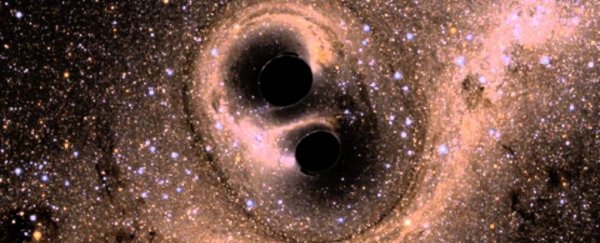Well, general relativity is still holding firm. According to a new test of Einstein's venerable theory, our Universe's gravity isn't leaking into other dimensions.
We are all very relieved to hear that our gravity isn't going to disappear into some weird dimension we can't even comprehend, obviously - after all, there are a slew of health problems that accompany hanging out in zero-G - but it's more of a theoretical conundrum than a real concern.
The prospect of an interdimensional gravity leak stems theoretically from the Universe's physical dimensions, which were a basis for Einstein's theory of general relativity - you know, the three spatial dimensions, and the fourth dimension, time - not aLtErNaTe DiMeNsIoNs like parallel universes.
If there are any dimensions out there beyond those four, we are unable to detect them - but gravitational waves looked to offer a potential way. So the large, international LIGO collaboration got together to check it out, along with other gravitational wave-based tests of relativity.
Their resulting paper is yet to be peer-reviewed, but its conclusions are consistent with every other test of general relativity to date.
In spacetime as we know it, both gravity and light exist. But in large extra dimensions - whatever a fifth, sixth, or seventh dimension is like - gravity might still exist, and light might not. And, theoretically at least, as gravitational waves ripple across spacetime in the wake of a colossal cosmic collision, some of the gravity could "leak" into these dimensions.
Luckily, it's actually a relatively simple test. And the research team had the perfect astronomical event to test it on: GW170817.
GW170817 was a huge deal. When astronomers got the first hint of gravitational wave activity at LIGO with a pinpointed location, every available telescope and observatory around the world turned its gaze to that region of the sky.
For the first time, we were actually able to see two neutron stars colliding. But, more than that - the fact that all those observatories were on the case gave us an unprecedented amount of data about the event - a treasure trove for follow-up study.
It also proved that light and gravitational waves travel at the same speed. According to the test the researchers devised, if gravity is getting slurped up by some weird unknown dimension, but light isn't, we would be able to detect a significant drop in the amplitude of the gravitational waves - compared to the loss of amplitude in light waves - by the time they both reached Earth's detectors.
But that didn't happen. The amplitude remained proportional. General relativity triumphed again - both in this test and the other tests to which the team subjected GW170817.
General relativity has survived test after test after test after test. But scientists are going to continue to try to break it. Breaking relativity is going to be a big deal - if it ever happens - but every time we've attempted it, the theory continues to hold up, and we learn a little bit more about our Universe.
"The upcoming observing runs of the LIGO and Virgo detectors are expected to result in more detections of binary neutron star coalescences," the researchers wrote in their paper.
"Along with electromagnetic observations, combining information from gravitational wave events (including binary black hole mergers) will lead to increasingly more stringent constraints on deviations from general relativity, or conceivably potential evidence of the theory's shortcomings."
The paper has been published in the preprint resource arXiv.
